Category: War








This is a list of infantry weapons of World War I (1914–1918).
Contents
[hide]
- 1Republic of Armenia
- 2Austro-Hungarian Empire
- 3Kingdom of Belgium
- 4 British Empire
- 5 Kingdom of Bulgaria
- 6Sultanate of Darfur
- 7Dervish State
- 8French Republic
- 9 German Empire
- 10 Kingdom of Greece
- 11Kingdom of Hejaz
- 12 Kingdom of Italy
- 13Emirate of Jabal Shammar
- 14 Empire of Japan
- 15 Kingdom of Montenegro
- 16Kingdom of Nepal
- 17 Ottoman Empire
- 18Portuguese Republic
- 19Emirate of Riyadh
- 20 Kingdom of Romania
- 21 Russian Empire
- 22 Kingdom of Serbia
- 23 United States of America
- 24Weapons used in trench raids
- 25References
 Republic of Armenia[edit]
Republic of Armenia[edit]
Handguns
Rifles
Machine guns
 Austro-Hungarian Empire[edit]
Austro-Hungarian Empire[edit]
Handguns
- Browning M1900
- Dreyse M1907
- Frommer M1912
- Gasser M1870, M1870/84, M1873 and M1876
- Mannlicher M1901
- Mauser C96
- Rast & Gasser M1898
- Roth–Sauer M1900
- Roth–Steyr M1907
- Steyr M1912
- Werder M1869
Rifles
- Gewehr 88/05
- Gewehr 98
- Kropatschek M1881 and M1893
- Mannlicher M1886/88
- Mannlicher M1888 and M1888/90
- Mannlicher M1890
- Mannlicher M1893
- Mannlicher M1895
- Mannlicher–Schönauer M1903/14
- Mauser M1903
- Mauser M1912
- Mondragón M1908
- Werndl–Holub M1877
- Wänzl M1867
Machine guns
Submachine guns
Grenades
Flamethrowers
Mortars
- Ehrhardt M1915
- Esslingen M1915
- Lanz
- Luftminenwerfer M1916
- Minenwerfer M1914 and M1914/16
- Minenwerfer M1915
- Minenwerfer M1917
- Roka-Halasz M1915
- Škoda M1915 and M1916
Swords
 Kingdom of Belgium[edit]
Kingdom of Belgium[edit]
Handguns
Rifles
- Albini M1867 (Used by Force Publique)
- Comblain M1882, M1883 and M1888
- Gras M1874
- Lebel M1886/M93
- Mauser M1889
Machine guns
Shotguns
- Browning Auto-5 (Used by Garde Civique)
 British Empire[edit]
British Empire[edit]
Handguns
- British Bull Dog
- Colt M1903 Pocket Hammerless
- Colt M1909
- Colt M1911
- Enfield Mk I & Mk II
- Lancaster
- Mauser C96
- Smith & Wesson M1899
- Smith & Wesson M1917
- Smith & Wesson Triple Lock
- Webley–Fosbery Automatic
- Webley Mk IV, Mk V and Mk VI
- Webley Self-Loading Mk I
Rifles
- Arisaka Type 30
- Arisaka Type 38
- Elephant gun
- Enfield P1914
- Farquhar–Hill P1918
- Farquharson
- Lee–Metford Mk I and Mk II
- Lee–Speed No. 1 and No. 2
- Magazine Lee–Enfield Mk I
- Mauser–Verqueiro M1904 (Used by South African units)
- Marlin M1894
- Martini–Enfield Mk I and Mk II
- Martini–Henry Mk IV
- Remington Model 14-1/2
- Remington Rolling Block M1901
- Ross Mk III (Used by Canadian units)
- Short Magazine Lee–Enfield Mk I, Mk II and Mk III
- Snider–Enfield Mk III
- Winchester M1886
- Winchester M1892
- Winchester M1894
- Winchester M1895
- Winchester M1907
Machine guns
- Browning M1917
- Colt–Browning M1895/14 (Used by Canadian units)
- Hotchkiss Mk I
- Lewis M1914
- Maxim M1884
- Vickers Mk I
Grenades
- Hales No. 2
- Hales No. 3
- Mills Nos. 5, No. 23 and No. 36
- No 1 Grenade
- No. 6 and No. 7
- No. 8 and No. 9 Double cylinder
- No. 15 and No. 16
Mortars
Projectile weapons
Support guns
Swords
Bayonets
Knives
 Kingdom of Bulgaria[edit]
Kingdom of Bulgaria[edit]
Handguns
Rifles
- Berdan M1870
- Gewehr 71
- Gras M1874
- Krnka M1867
- Mannlicher M1886/88
- Mannlicher M1888 and M1888/90
- Mannlicher M1890
- Mannlicher M1895
- Mosin–Nagant M1891
- Peabody–Martini–Henry M1874
Machine guns
Flamethrowers
 Sultanate of Darfur[edit]
Sultanate of Darfur[edit]
Rifles
Shotguns
Swords
Polearms
 Dervish State[edit]
Dervish State[edit]
Rifles
- Gras M1874
- Jezail
- Lebel M1886/M93
- Lee–Metford Mk I and Mk II
- Martini–Henry Mk IV
- Remington Rolling Block M1867
Machine guns
Swords
 French Republic[edit]
French Republic[edit]
Handguns
- Browning M1900
- Chamelot–Delvigne M1873 and M1874
- Colt M1892
- Colt M1911
- Ruby M1914
- Savage M1907
- Smith & Wesson M1899
- Star M1914
- St. Etienne M1892
Rifles
- Berthier M1890, M1892, M1892/16, M1902, M1907, M1907/15 and M1916
- Chassepot M1866/74
- Gras M1874 and M1874/14
- Kropatschek M1884 and M1885
- Lebel M1886/M93
- Lee–Metford Mk I and Mk II
- Meunier M1916
- Remington–Lee M1887
- Remington Model 8
- Remington Rolling Block M1867 and M1914
- RSC M1917 and M1918
- Winchester M1894
- Winchester M1907
- Winchester M1910
Machine guns
- Chauchat M1915
- Colt–Browning M1895/14
- Hotchkiss M1909
- Hotchkiss M1914
- Puteaux M1905
- St. Étienne M1907 and M1907/16
Anti-tank weapons
Grenades
Flamethrowers
Mortars
Projectile weapons
Support guns
Knives
Swords
 German Empire[edit]
German Empire[edit]
Handguns
- Bayard M1908
- Beholla
- Bergmann–Bayard M1910
- Dreyse M1907
- Frommer M1912
- Luger P04 and P08
- Mauser C96
- Mauser M1878 and M1886
- Mauser M1910 and M1914
- Reichsrevolver M1879 and M1883
- Schwarzlose M1908
- Steyr M1912
Rifles
- Elefantengewehr
- Gewehr 71 and 71/84
- Gewehr 88/05 and 88/14
- Gewehr 98
- Mauser M1915 and M1916
- Mondragón M1908
- Werder M1869
Machine guns
- Bergmann MG 15nA
- Dreyse MG 12
- Gast M1917
- Madsen M1902
- MG 08, MG 08/15 and MG 08/18
- MG 14 and MG 14/17
- MG 18 TuF
Submachine guns
Anti-tank weapons
Grenades
Mines
Flamethrowers
Mortars
Support guns
Swords
 Kingdom of Greece[edit]
Kingdom of Greece[edit]
Handguns
- Bergmann–Bayard M1903
- Browning M1900
- Browning M1903
- Chamelot–Delvigne M1873, M1874 and M1884
- Colt Army Special
- Mannlicher M1901
- Nagant M1895
- Ruby M1914
Rifles
- Berthier M1892 and M1892/16
- Berthier M1907/15 and M1916
- Gras M1874
- Lebel M1886/M93
- Mannlicher–Schönauer M1903 and M1903/14
Machine guns
Mortars
 Kingdom of Hejaz[edit]
Kingdom of Hejaz[edit]
Handguns
Rifles
- Arisaka Type 30
- Arisaka Type 38
- Gras M1874
- Jezail
- Lebel M1886/M93
- Peabody–Martini–Henry M1874
- Short Magazine Lee–Enfield Mk III
Machine guns
 Kingdom of Italy[edit]
Kingdom of Italy[edit]
Handguns
- Beretta M1915
- Bodeo M1889
- Brixia M1912
- Chamelot–Delvigne M1873 and M1874
- Glisenti M1910
- Mauser C96
- Ruby M1914
- Smith & Wesson No. 3
Rifles
- Berthier M1892, M1892/16, M1907/15 and M1916
- Carcano M1891
- Lebel M1886/M93
- Vetterli M1870, M1870/87 and M1870/87/15
Machine guns
- Chauchat M1915
- Colt–Browning M1895/14
- Fiat–Revelli M1914
- Gardner M1886
- Hotchkiss M1914
- Lewis M1914
- Maxim M1906 and M1911
- Nordenfelt M1884
- Perino M1908
- St. Étienne M1907
- Vickers Mk I
Submachine guns
Grenades
Flamethrowers
Mortars
 Emirate of Jabal Shammar[edit]
Emirate of Jabal Shammar[edit]
Rifles
- Gras M1874
- Martini–Henry Mk IV
- Mauser M1887
- Mauser M1890
- Mauser M1893 and M1903
- Snider–Enfield Mk III
Machineguns
 Empire of Japan[edit]
Empire of Japan[edit]
Handguns
Rifles
Machine guns
Swords
Bayonets
 Kingdom of Montenegro[edit]
Kingdom of Montenegro[edit]
Handguns
- Gasser M1870/74 and M1880
- Mannlicher M1901
- Rast & Gasser M1898
- Smith & Wesson M1899
- Smith & Wesson No. 3
Rifles
Machine guns
 Kingdom of Nepal[edit]
Kingdom of Nepal[edit]
Rifles
Machine guns
Knives
 Ottoman Empire[edit]
Ottoman Empire[edit]
Handguns
Rifles
- Gewehr 88/05
- Gewehr 98
- Martini–Henry Mk I
- Mauser M1887
- Mauser M1890
- Mauser M1893, M1903 and M1908
- Mauser M1905
- Peabody–Martini–Henry M1874
- Remington Rolling Block M1866
- Snider–Enfield Mk III
- Winchester M1866
Machine guns
Grenades
Flamethrowers
 Portuguese Republic[edit]
Portuguese Republic[edit]
Handguns
Rifles
- Kropatschek M1886
- Mannlicher M1896
- Mauser-Verqueiro M1904
- Short Magazine Lee–Enfield Mk III (Used by Portuguese forces on the Western Front)
Machine guns
Mortars
 Emirate of Riyadh[edit]
Emirate of Riyadh[edit]
Rifles
- Arisaka Type 30
- Arisaka Type 38
- Gras M1874
- Jezail
- Martini–Enfield Mk I and Mk II
- Martini–Henry Mk IV
- Mauser M1887
- Mauser M1890
- Mauser M1893 and M1903
- Short Magazine Lee–Enfield Mk III
 Kingdom of Romania[edit]
Kingdom of Romania[edit]
Handguns
Rifles
- Berthier M1907/15
- Gras M1874
- Lebel M1886/M93
- Mannlicher M1888/90
- Mannlicher M1893
- Mannlicher M1895
- Mosin–Nagant M1891
- Peabody–Martini–Henry M1879
- Vetterli M1870/87
Machine guns
- Chauchat M1915
- Colt–Browning M1895/14
- Hotchkiss M1914
- Lewis M1914
- Maxim M1907 and M1909
- MG 08
- Schwarzlose M1907/12
- St. Étienne M1907
- Vickers Mk I
 Russian Empire[edit]
Russian Empire[edit]
Handguns
Rifles
- Arisaka Type 30
- Arisaka Type 35
- Arisaka Type 38
- Berdan M1868 and M1870
- Berthier M1907/15
- Carl M1865
- Chassepot M1866/74
- Fedorov Avtomat M1916
- Gras M1874
- Krnka M1867
- Kropatschek M1878 and M1884
- Lebel M1886/M93
- Mosin–Nagant M1891 and M1907
- Remington Rolling Block M1910
- Springfield M1892
- Vetterli M1870 and M1870/87
- Winchester M1895
- Winchester M1907
- Winchester M1910
Machine guns
- Chauchat M1915
- Colt–Browning M1895/14
- Hotchkiss M1909
- Lewis M1914 and M1917
- Madsen M1902
- Maxim M1905
- Maxim M1910
- Vickers Mk I
Grenades
Mortars
Support guns
Swords
 Kingdom of Serbia[edit]
Kingdom of Serbia[edit]
Handguns
- Chamelot–Delvigne M1873, M1874 and M1876
- Gasser M1870/74
- Luger P08
- Mauser C96
- Nagant M1891
- Ruby M1914
Rifle
- Berdan M1868 and M1870
- Berthier M1892, M1892/16 and M1907/15
- Gras M1874
- Lebel M1886/M93
- Mauser M1878/80, M1880/07 and M1884
- Mauser M1899, M1899/07 and M1908
- Mauser M1910
- Mosin–Nagant M1891
Machine guns
Grenades
Mortars
 United States of America[edit]
United States of America[edit]
Handguns
- Colt M1889
- Colt M1892
- Colt M1903 Pocket Hammerless
- Colt M1905
- Colt M1909
- Colt M1911
- Colt M1917
- Savage M1907
- Smith & Wesson M1899
- Smith & Wesson M1917
Rifles
- Berthier M1907/15
- Enfield M1917
- Short Magazine Lee–Enfield Mk III
- Springfield M1896 and M1898
- Springfield M1903
Machine guns
- Benét–Mercié M1909
- Browning M1917
- Browning M1918
- Chauchat M1915 and M1918
- Colt–Browning M1895/14
- Colt–Vickers M1915
- Hotchkiss M1914
- Lewis M1917
Shotguns
Grenades
Mortars
Support guns
Bayonets
Knives
Weapons used in trench raids[edit]
- Billhook
- Brass knuckles
- Claymore
- Entrenching tool
- Fascine knife
- French Nail
- Hatchet
- Knife bayonet
- Kukri
- Mace
- Machete
- Pickaxe handle
- Push dagger
- Sabre
- Spade
- Stiletto
- Trench knife
- Trench raiding club
References[edit]
- David Miller. (2003). “The Illustrated Directory of 20th Century Guns”. Minneapolis, Minnesota: Zenith Imprint. ISBN 9780760315606.
- David Nicolle. (1989). “Lawrence and the Arab Revolts”. Cumnor Hill, Oxford: Osprey Publishing. ISBN 0850458889.
- James H. Willbanks. (2004). “Machine Guns: An Illustrated History of Their Impact”. Santa Barbara, California: ABC-CLIO. ISBN 1851094806.
- Jeff Kinard. (2004). “Pistols: An Illustrated History of Their Impact”. Santa Barbara, California: ABC-CLIO. ISBN 1851094709.
- John Walterll. (2006).”The Rifle Story: An Illustrated History from 1756 to the Present Day”. Norwalk, Connecticut: MBI Publishing Company. ISBN 9781853676901.
- Robert W.D. Ball. (2011). “Mauser Military Rifles of the World”. Iola, Wisconsin: New York City, New York: F+W Media, Inc. ISBN 9781440228803.
- Wayne Zwoll. (2003). “Bolt Action Rifles”. Iola, Wisconsin: Krause Publications. ISBN 1440224064.
(Operation Pastorius – Wikipedia)
After the Japanese attack on Pearl Harbor on 7 December 1941, followed by Nazi Germany’s declaration of war on the United States four days later[1] (and the United States’ declaration of war on Germany in response), Hitler authorized a mission to sabotage the American war effort and to make terrorist attacks on civilian targets to demoralize the American civilian population inside the United States.[2] The mission was headed by Admiral Canaris, chief of the German Abwehr. Canaris recalled that during World War I, he organized the sabotage of French installations in Morocco, and entered the United States with other German agents to plant bombs in New York arms factories, including the destruction of munitions supplies at Black Tom Island, in 1916. He hoped that Operation Pastorius would have the same kind of success they had in 1916.[3]
I remember my Father telling me what little he knew, in guarded terms of the events. He had been deferred to to asthma and flat feet, but was anxious to somehow to serve. Little did he know what was to befall him.
Meanwhile, one of the potential saboteurs betrayed the others, and they all were arrested , tried and convicted. My father (and his father) were then civilian police for the New York, New Haven and Hartford Railroad, and were commandeered as private ‘volunteered’ to transport prisoners through the Easter United States. This was all Top Secret, was all kept secret until the 60’s. Much of what my Father shared with me he thought remained with so, as he was unaware of the earlier declassification!
He was given no official title or rank, and was not paid – the RR paid him.









I will not hon0r these men by linking their names with their photos.
The trial for the eight defendants ended on 1 August 1942. Two days later, all were found guilty and sentenced to death. Roosevelt commuted Burger’s sentence to life in prison and Dasch’s to 30 years because they had turned themselves in and provided information about the others.
The others were executed on 8 August 1942 in the electric chair on the third floor of the District of Columbia jail and buried in a potter’s field in the Blue Plains neighborhood in the Anacostia area of Washington.
And was told never to speak of this…
This irked me my entire childhood – friends whose fathers who served in the Pacific Theater, the Atlantic, and my Dad had flat feet!
What did you do in the War Daddy?
What little did I know…
I was always proud of my father – more proud today.
Different opponents faced by the British Victorian Army
As I recall part of the British soldier to deal and adapt was part of the Victorian heritage that was prevalent at the time, the British soldiers and the culture believed that they were superior to everyone because they were British, it was part of the DNA. For this reason they pushed the sphere of influence to a point where it was said that “The Sun never sets on the British Empire“. Also I remembered another movie with Michael Caine and Sean Connery “The man who would be King”
It is a different time and I wonder what a Britisher from back then would think about the empire today and the problems that the British are having from the E.U and the invasions of the “Kiffirs” from the subcontinents.
Maintaining your status as a global power is no easy thing. The British Victorian Army was one of the best equipped and most experienced in the world, its forces active from North Africa to the South Pacific. But while this gave many British soldiers useful experience, it also created unique challenges for them, their commanders and the politicians putting them into the field.
The British army was the same wherever they went, but their opponents were wildly different, each one presenting a new combination of skills, tactics, and weaponry for the British to overcome.
1. EGYPTIAN NATIONALISTS
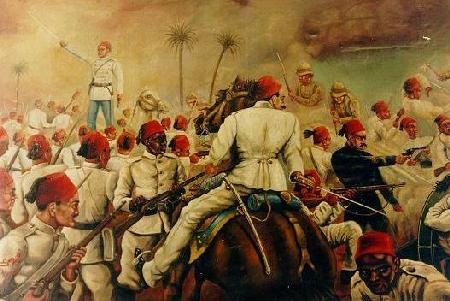
By 1879, the Egyptian government was massively corrupt, inefficient, and favorable to Europeans over locals. Even the law gave better protection to wealthy Europeans in the country than its native inhabitants. France and Britain in particular held huge sway.
Egyptian nationalists led by Colonel Ahmed ‘Urabi seized control of the country, seeking to bring about democratic reforms that would take power away from the elite and reduce foreign influence. France refused to intervene. Britain, on the other hand, used the death of 50 Europeans in riots to justify an invasion in 1882, whose real purpose was the defense of economic interests.
The forces they faced were trained and equipped by Europeans and fought like a regular army. But the British proved superior, defeating ‘Urabi at the Battle of Tel-el-Kebir and taking control of Egypt.
2. ASHANTI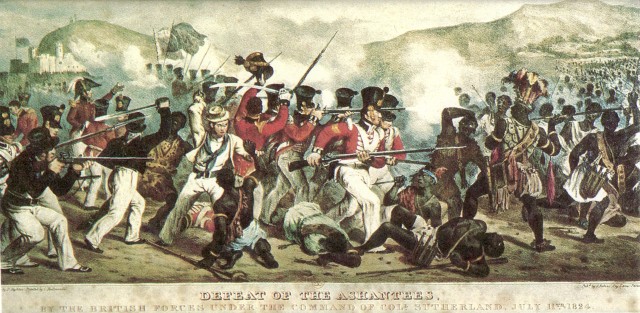 The defeat of the Ashantees, by the British forces under the command of Coll. Sutherland, July 11th, 1824.
The defeat of the Ashantees, by the British forces under the command of Coll. Sutherland, July 11th, 1824.
As in Egypt, the British fought the Ashanti Empire, located in modern Ghana, for control of economic resources. They wanted to control gold from the region, and ownership or favorable peace treaties could prevent other European powers from getting involved.
The Ashanti were primitively armed but experienced and smart at fighting in local terrain. Launching ambushes out of the hills and jungle, they gained the element of surprise and often outflanked their opponents.
The downside of Ashanti tactics was a lack of cohesion and close order discipline. In the face of increasingly accurate rifles, dispersed troops were more vulnerable than they had been a century before. Unable to break British formations, they were repeatedly defeated.
Perhaps the most famous of Britain’s colonial opponents, the Zulu Empire was defended by warriors called impis. Tough and aggressive, they could run for miles before charging into battle and overwhelming their opponents with short stabbing spears. They were also highly disciplined, able to maneuver swiftly and coherently on command and willing to throw themselves in waves against the enemy.
To gather together various territories in southern Africa, the British needed to conquer the Zulus. They sent an ultimatum that triggered the war and then invaded Zulu lands.
The Zulus achieved an early victory at Isandlwana, where appalling leadership crippled the British forces. The famous defense of Rorke’s Drift followed, in which 150 British and colonial troops fought off 3-4,000 Zulus in a desperate engagement.
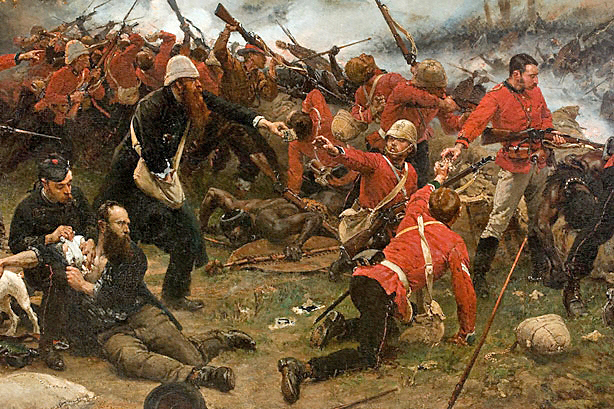
Despite these early events, the ferocity, tenacity, and courage that had served the Zulus so well were not enough to let Spears beat modern guns. By the final Battle of Ulundi, courageous charges were creating massive casualties for little gain. However, the war had shaken British confidence, teaching some not to under-estimate a technologically inferior force.
4. MAORIS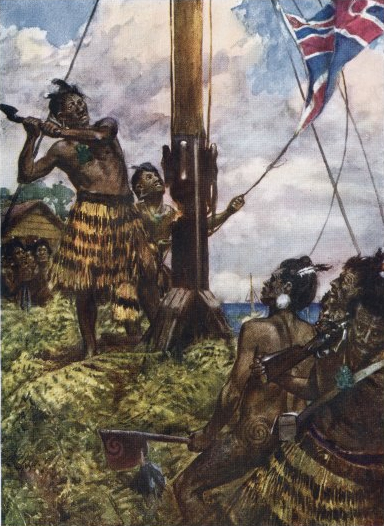 Hone Heke cuts down the flagstaff on Flagstaff Hill at Kororāreka.
Hone Heke cuts down the flagstaff on Flagstaff Hill at Kororāreka.
A similar lesson was taught in the New Zealand Wars (1845-1872). With settlers spreading across New Zealand, and the colonial authorities backing them against the native Maoris, many locals took up arms to resist.
The Maori way of warfare was the polar opposite of that used by the Zulus. Impi tactics were flowing and aggressive, adapted to fight other African tribes. Those of the Maoris were stationary and defensive, adapted to counter European guns. Creating fortified earthen strongholds called pā, the Maoris held off British and then colonial militia troops, firing from well-prepared defensive positions, forcing the attackers into costly advances. Though the result was once again domination by white colonials, fighting was nowhere near as decisive as in the Zulu Empire.
5. XHOSA
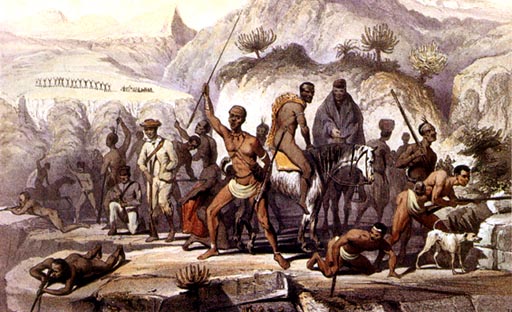
The Zulus were not the only natives the British fought in their attempt to unite southern Africa. Further, east, the Xhosa also resisted, triggering the Ninth Xhosa War (1877-9)
Unable to beat the well-equipped British in open battle, the Xhosa retreated to the Amatola Mountains. Here they fought a guerrilla war, making use of the terrain to launch a string of ambushes. By never presenting the British with a target and always withdrawing when put under pressure, they prevented the invaders from gaining an advantage. It was only by building a string of fortifications and creating an elaborate system of mounted pursuit that the British beat them.
6. MAHDISTS

The Mahdists in Sudan faced the British with a different challenge in the 1880s and 1890s. Believing their leader Muhammad Ahmad to be the Mahdi, a prophesied Islamic religious leader, they fought with fanatical fervor against foreign influence.
This religious fervor led to frontal assaults even more determined than those of the Zulus. Though these served the Mahdists well early on, they were no match for well-prepared troops equipped with the latest guns. It was such a force that broke them finally broke them at Omdurman in 1898.
7. BOERS
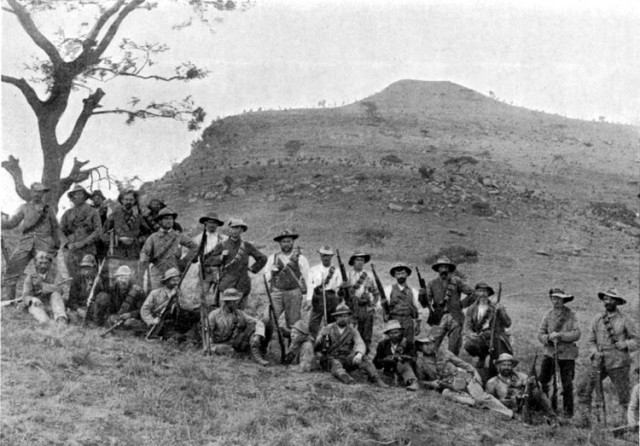
While many opponents used elements of guerrilla warfare against the British, the Boer version came closest to what we see in the modern world. The descendants of Dutch settlers, the Boers became caught up in the British attempt to unify southern Africa, and like the natives they resisted.
Smart, accurate marksmen with talented leaders who understood European warfare, they were foes unlike any others the British had faced. They were able to gain large armies and adapt elements of guerrilla warfare to the battlefield, defeating the British in bloody confrontations as well as small actions.
Ultimately, the Boers were undone not by their enemies’ superior tactics or leadership. Indeed, British leadership in the war was often among the worst in history. Yet even the tenacious Boers could not defeat the superior resources of the British Empire, and sheer weight of numbers eventually wore them down

or
How To Break Down A Door

Alright, let’s get this out of the way first: kicking down a door is not the best option for opening a locked door. It will damage the door and cost you lots of money to fix it. It is better to call a locksmith, pick the lock, or attempt to crawl in a window.
But let’s say it’s an emergency. You’re in a burning house and you need to escape and the door is on fire. Or your loved ones are in a burning house and you’re locked out. You can’t stand there fiddling with the lock, you’ve got to break it down! Or perhaps a loved one is stricken with a medical emergency and is locked inside a room or in their house. What to do? Be a man, dammit! Break down that door! You know you’ve always wanted to.
How to break down a door
If you have watched enough movies, your next move is a no brainer….run at the door shoulder first, right? Wrong. This technique may be uber-manly, but it will probably dislocate your shoulder. It is better to employ a more forceful and well placed kick.
Check to see which way the door opens by checking the hinges.If the door opens towards you, kicking it down is going to be next to impossible. Kicking a door down is best employed on a door that swings away from you.
Kick to the side of where the lock is mounted (near the keyhole).This is typically the weakest part of the door.
Using a front kick, drive the heel of your foot into the door. Give the kick forward momentum and keep your balance by driving the heel of your standing foot into the ground. Don’t kick the lock itself; this could break your foot.
The wood should begin to splinter. Today most doors are made of soft wood and are hollow. They should give way fairly easily, especially since the lock’s deadlock bolt extends only an inch or less into the door frame. Older, completely solid doors will prove more resistant. Just keep on kicking until the door gives way and you can save the day.
Avoid jump kicks. While you may be tempted to employ this manly move, jumping diminishes your stability which causes you to lose power.
I have seen and worked with a few of the Queen’s Soldiers. Most of whom are some pretty good guys. In Spite of the times that I could not understand a word they were saying!
But the bottom line with these guys. Is that they are they are a lot of fun and some really hard fighting folks that I am glad are on our side!
Grumpy







